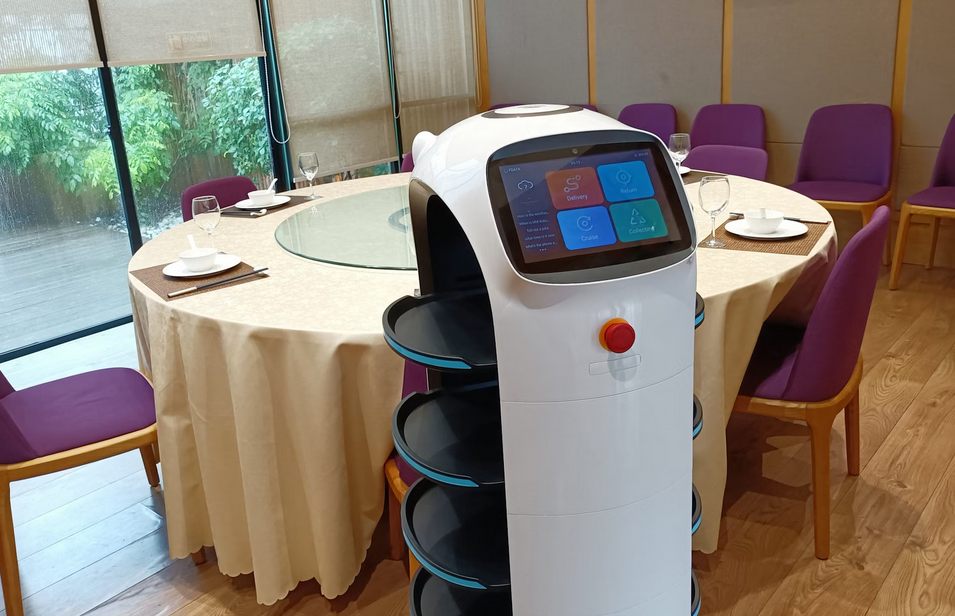Are you tired of frustrated customers struggling with confusing phone systems or long wait times to make reservations? Imagine offering a seamless experience where patrons can effortlessly book, modify, or even provide updates on their reservations simply by speaking to an AI-powered virtual assistant.
This cutting-edge technology understands different accents, answers common questions in real-time without frustrating phone menus, and handles reservation changes effortlessly – all without involving your staff. But that’s not all; you can customize which interactions the AI handles and which get seamlessly handed off to your team, ensuring the perfect balance of technology and human touch. This article explores how AI elevates customer guidance in restaurants.
The Revolution of Customer Service in Restaurants Through AI
The integration of AI in restaurants has ushered in a new era of customer service, transcending traditional models and pushing the boundaries of personalization. Leading this charge is the restaurant AI phone answering system, capable of understanding customer queries, providing personalized recommendations, and handling reservations efficiently. This seamless integration of AI technology signals a shift towards data-driven, individualized dining experiences that cater to each customer’s unique needs and preferences. This innovative approach not only enhances customer satisfaction but also promises to boost business growth.
Restaurants that effectively leverage AI for personalized recommendations experience an increased likelihood of repeat visits and positive word-of-mouth, ultimately driving sales and customer retention.
Source: ResearchAndMarkets
The Mechanism Behind AI-Driven Recommendations
At the heart of this revolution lies a sophisticated technological framework that enables AI to provide smart recommendations. By leveraging machine learning algorithms and predictive analytics, these systems can analyze vast amounts of data, including historical customer preferences, dietary restrictions, and past orders, to anticipate individual tastes and preferences.
The process begins with data collection, where restaurants gather information from various sources, such as online orders, loyalty programs, and customer feedback. This data is then fed into machine learning models, which identify patterns and trends, enabling the AI to make accurate predictions about what a customer might enjoy.
Furthermore, AI-driven recommendation systems seamlessly integrate with existing restaurant management platforms, ensuring a cohesive and streamlined operation. This integration allows for real-time updates and adjustments, ensuring that recommendations remain relevant and tailored to each customer’s evolving preferences.
Benefits of AI-Enabled Customer Guidance
The implementation of AI-driven customer guidance in restaurants yields numerous benefits, enhancing the overall dining experience while driving operational efficiencies.
Personalized Dining Experience
One of the most significant advantages of AI is its ability to deliver truly personalized recommendations. By analyzing individual preferences and dietary requirements, AI can suggest menu items tailored to each customer’s unique tastes and needs. This level of personalization not only enhances customer satisfaction but also fosters loyalty and repeat business.
Efficiency and Speed
AI systems can process and analyze vast amounts of data in real-time, enabling restaurants to deliver prompt and accurate recommendations. This efficiency translates into reduced wait times, streamlined service, and an overall improved customer experience, contributing to customer satisfaction and operational productivity.
Increased Sales and Customer Retention
By leveraging AI’s predictive capabilities, restaurants can upsell complementary items or suggest higher-priced menu options that align with a customer’s preferences. This strategic approach not only boosts sales but also enhances customer loyalty, as patrons feel understood and valued, increasing the likelihood of repeat visits.
Beyond menu recommendations, AI offers additional capabilities to enhance customer service in restaurants.
Answer Questions
AI-powered virtual assistants can understand different accents, answer common questions, and respond in real-time without frustrating phone menus, providing a seamless and efficient customer experience.
Manage Reservations
Customers can easily book, modify, or even provide updates on their reservation status, such as running late, all without involving staff, streamlining the process and reducing administrative workload.
Customize Experiences
Restaurants can decide which calls and interactions AI will handle and which ones will be seamlessly handed off to human staff, ensuring a balance between technology and personal touch.
Challenges and Considerations in Adopting AI for Restaurants
While the benefits of AI in the restaurant industry are compelling, adopting this technology is not without its challenges. Restaurants must navigate technological and financial hurdles to successfully integrate AI-driven systems.
Technological Barriers
Implementing AI requires a robust technological infrastructure, including data storage and processing capabilities, as well as seamless integration with existing restaurant management systems. Ensuring data privacy and security is also a critical consideration, as customer information must be handled responsibly and in compliance with regulations.
Financial Investment
Developing and deploying AI solutions can be a significant financial undertaking, particularly for smaller restaurants or independents. The costs associated with software development, hardware upgrades, staff training, and ongoing maintenance can be substantial. However, the potential return on investment (ROI) in terms of increased efficiency, customer satisfaction, and revenue growth may justify the initial investment.
Balancing Technology and Human Touch
While AI offers numerous advantages, it is essential to strike a balance between technology and human interaction. Restaurants must ensure that AI complements rather than replaces the personal touch that is often a hallmark of exceptional dining experiences. Finding the right balance is crucial to maintaining a warm and welcoming atmosphere while leveraging the power of AI.
The Future of Dining: Predictions and Emerging Trends
As AI continues to evolve and permeate the restaurant industry, we can expect to see even more innovative applications and features emerge. Here are some predictions and emerging trends shaping the future of dining:
-
Enhanced Personalization: AI systems will become increasingly adept at analyzing complex data points, such as social media activity, location data, and even biometric information, to deliver hyper-personalized recommendations tailored to individual preferences and circumstances.
-
Predictive Inventory Management: By analyzing historical sales data and customer preferences, AI can help restaurants optimize inventory levels, reducing waste and ensuring the availability of popular menu items.
-
Voice and Gesture-Based Ordering: Voice-enabled virtual assistants and gesture recognition technology will enable customers to place orders, ask questions, and interact with restaurant systems in a more natural and intuitive manner.
-
Augmented Reality (AR) and Virtual Reality (VR) Experiences: Restaurants may leverage AR and VR technologies to offer immersive dining experiences, allowing customers to visualize menu items, explore virtual environments, or even participate in interactive culinary experiences.
As the restaurant industry continues to embrace AI, it will be crucial for businesses to stay agile, adapt to emerging trends, and continuously refine their strategies to deliver exceptional customer experiences while maintaining operational efficiency.
Final Thoughts
The integration of AI in the restaurant industry is revolutionizing customer service and elevating the dining experience to new heights. From personalized menu recommendations to streamlined reservation management, AI-driven systems are transforming the way restaurants interact with their patrons, offering a seamless and tailored culinary journey.
As the industry continues to evolve, restaurants that embrace AI and stay ahead of emerging trends will be well-positioned to thrive in an increasingly competitive landscape. The future of dining is not just about embracing technology but about mastering its integration to deliver truly personalized and exceptional experiences that keep customers coming back for more.
So, whether you’re a national chain or a local eatery, it’s time to explore the world of AI and unlock its potential to elevate your customer guidance and redefine the art of hospitality.
Frequently Asked Questions
1. How does AI respect customer privacy while collecting data for personalized recommendations?
Restaurants prioritize customer privacy and adhere to strict data protection measures and consent protocols. Customer data is anonymized and secured using industry-standard encryption techniques. Additionally, customers have the option to opt-out of data collection or modify their preferences at any time.
2. Can AI recommendations cater to complex dietary restrictions and allergies?
Yes, AI systems are specifically trained to recognize and accommodate complex dietary restrictions and allergies. By analyzing ingredient lists, nutritional information, and customer preferences, AI can suggest menu options that meet specific health and dietary needs, ensuring a safe and enjoyable dining experience for all customers.
3. What is the initial investment required to implement AI-driven recommendation systems in restaurants?
The initial investment required to implement AI-driven recommendation systems can vary based on factors such as the size of the restaurant, the complexity of the solution, and the existing technological infrastructure. Generally, costs may include software development, hardware upgrades, staff training, and ongoing maintenance. However, many restaurants see a significant return on investment through increased efficiency, customer satisfaction, and revenue growth.



